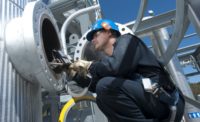When is it necessary to wear double hearing protection?

Photo credit: PK Safety
Even in today’s advanced industrial environments, occupational hearing loss remains one of the most common work-related issues in the US. Many machines and industrial processes emit loud noises that can compromise workers’ hearing, especially in industries such as construction, manufacturing, mining, and aviation. The Centers for Disease Control and Prevention (CDC) estimates that around 22 million US workers are exposed to hazardous noise levels each year.
In a review published in the International Journal of Environmental Research and Public Health, researchers said, “Occupational noise exposure accounts for approximately 16% of all disabling hearing losses, but the true value and societal costs may be grossly underestimated.”
Understanding dangerous noise levels
According to the Occupational Safety and Health Administration (OSHA) standards, workers should not be exposed to an average sound level exceeding 85 decibels (dB) over an eight-hour workday. To put this in perspective, a police car siren, a passing train, and a vacuum cleaner produce sound equivalent to 85 dB. It’s important to note that this is just the permissible exposure limit (PEL). Ideally, employers should strive to keep noise levels below these thresholds whenever possible.
Prolonged exposure to loud noises damages the delicate hair cells within the inner ear. These cells convert sound waves into electrical signals that the brain interprets as sound. Damaged hair cells can result in tinnitus (ringing in the ears), difficulty understanding speech, and even complete deafness. Moreover, prolonged exposure to high noise levels can also lead to other health issues, such as stress, hypertension, and increased heart rate, compounding the physical toll on workers.
In the same review referenced earlier, researchers said, “Beyond the audiogram, there is growing awareness that hearing loss is a significant risk factor for other debilitating and potentially life-threatening disorders such as cardiovascular disease and dementia.”
Double hearing protection: An essential safety measure
As the term suggests, double hearing protection refers to using two protective devices at the same time. The most common and easiest way to double up on hearing protection is to wear earplugs underneath earmuffs. This method is recommended in environments where noise levels exceed 100 dB.
Every hearing protection device has a Noise Reduction Rating (NRR) indicating how much it reduces noise exposure levels against a standardized test method. For example, if a protective device has an NRR of 30 dB, workers in an environment with an average noise level of 100 dB would only be exposed to 70dB when wearing the hearing protection. In practice this can vary due to factors that include employee training and fit.
When is double hearing protection necessary?
The following scenarios may require double hearing protection:
High-noise environments: Work settings with noise levels consistently exceeding 100 dB, such as mining, forestry, construction, and heavy manufacturing.
Uncertain noise levels: When noise levels fluctuate significantly throughout the workday, double protection ensures adequate protection even during peak noise periods.
Ineffective single protection: If a single protection device doesn’t provide the NRR required by the work environment, doubling up is necessary to achieve the optimal protection level. Additionally, double protection can compensate for earplugs that don’t fit snugly in the ear canal or earmuffs that don’t seal properly around the ears.
However, it’s important to note that double hearing protection isn’t a one-size-fits-all solution. Overprotection can also create communication difficulties and hinder situational awareness. It’s always best to consult a safety professional to determine your workplace’s specific needs to achieve the appropriate level of noise reduction without compromising other critical functions.
Choosing the right double hearing protection
To determine the appropriate hearing protection, start by measuring the average noise levels in the workplace using a sound meter. Workers need additional sound protection in environments where the average noise levels exceed 100 dB. If you don’t have access to a sound meter, a good rule of thumb is that if workers can’t hear each other from three feet away using a normal speaking voice, the sound levels are likely above 85 dB.
Here are some popular hearing protection combinations:
Earplugs + earmuffs: This is the most common and effective method of double hearing protection. Earplugs provide a good seal within the ear canal, while earmuffs create an additional sound barrier around the ear.
Canal caps + ear muffs: Canal caps have bands you can hang around your neck when not in use. So, while they don’t provide the same level of protection as earplugs, canal caps are a convenient solution, especially for environments where hearing protection is only needed for short periods. Please note that the band portion of the canal cap may interfere with the earmuff seal against the head.
Consider the following when selecting the appropriate double hearing protection:
Compatibility and fit: Ensure workers can wear the two chosen devices comfortably together without creating discomfort or pressure points. In addition, the two should not compromise proper fit as much as possible.
Protection level: The combined NRR of the two devices should be sufficient to reduce noise levels below the safe exposure limit.
Communication needs: In some workplaces, workers still need to communicate; consider options like electronic earmuffs that facilitate hearing speech while blocking harmful noise.
Under OSHA’s Noise Standard, employers are required to measure noise levels and provide free annual hearing exams, hearing protection, and training, among other administrative controls, to safeguard workers from occupational hearing loss. Consult a safety professional to ensure workers are equipped with the most appropriate hearing protection for specific tasks and work environments.
Looking for a reprint of this article?
From high-res PDFs to custom plaques, order your copy today!









